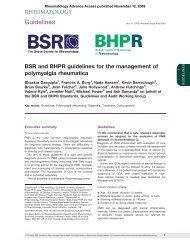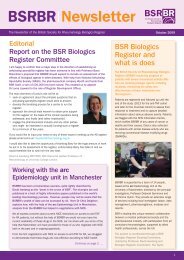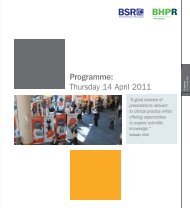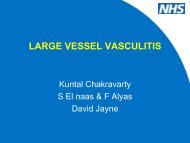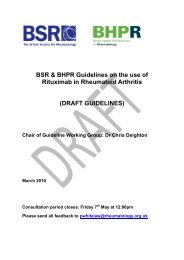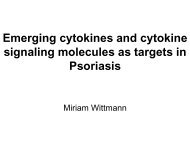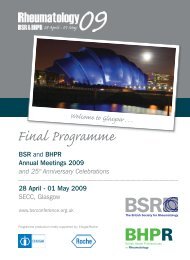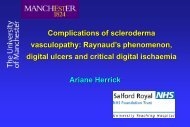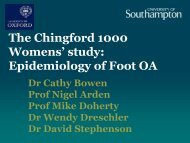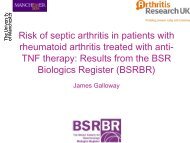Guidelines for the treatment of psoriatic arthritis with biologics
Guidelines for the treatment of psoriatic arthritis with biologics
Guidelines for the treatment of psoriatic arthritis with biologics
Create successful ePaper yourself
Turn your PDF publications into a flip-book with our unique Google optimized e-Paper software.
Recommendation one<br />
Anti‐TNF <strong>the</strong>rapy should be considered <strong>for</strong> those patients <strong>with</strong> active <strong>arthritis</strong> (defined as at least 3 tender and<br />
3 swollen joints) who have failed <strong>treatment</strong> <strong>with</strong> at least 2 conventional DMARDs*. Anti‐TNF <strong>the</strong>rapy may be<br />
considered <strong>for</strong> patients who have failed only one DMARD especially where <strong>the</strong>re is evidence <strong>of</strong> adverse<br />
prognostic factors** (Grade A)<br />
*e.g. leflunomide, methotrexate, sulfasalazine, ciclosporin<br />
** adverse prognostic factors defined as 5 or more swollen joints <strong>with</strong> elevated CRP persisting <strong>for</strong> more than 3<br />
months, and/or structural joint damage due to disease, and/or previous use <strong>of</strong> oral corticosteroids<br />
Recommendation two<br />
All <strong>of</strong> <strong>the</strong> licensed anti‐TNF <strong>the</strong>rapies are recommended <strong>for</strong> use in patients eligible <strong>for</strong> <strong>treatment</strong> and choice <strong>of</strong><br />
<strong>the</strong>rapy should be left to <strong>the</strong> treating physician after considering concomitant medical problems, patient<br />
preference and cost effectiveness. For patients requiring rapid control <strong>of</strong> skin psoriasis an anti‐TNF monoclonal<br />
antibody is preferred in accordance <strong>with</strong> British Association <strong>of</strong> Dermatology (BAD) guidelines 2 (Grade A)<br />
Recommendation three<br />
The Psoriatic Arthritis Response Criteria (PsARC) are recommended as <strong>the</strong> clinical response criteria <strong>for</strong><br />
peripheral <strong>psoriatic</strong> <strong>arthritis</strong> and a Psoriasis Area Severity Index (PASI) score should be completed <strong>for</strong> patients<br />
<strong>with</strong> skin psoriasis. In future, following appropriate validation, static composite measures evaluating all<br />
aspects <strong>of</strong> <strong>psoriatic</strong> disease should be used to assess eligibility and response in PsA. (Grade A)<br />
Recommendation four<br />
Anti‐TNF <strong>the</strong>rapies should be continued in patients who have responded after three months or <strong>treatment</strong>. In<br />
<strong>the</strong> case <strong>of</strong> non‐responders, consideration should be given to a fur<strong>the</strong>r 12 weeks <strong>of</strong> <strong>the</strong>rapy if <strong>the</strong>re has been a<br />
partial response*and <strong>the</strong>n continuing <strong>the</strong>rapy if <strong>the</strong>re has been a full response compared to baseline (Grade B)<br />
*A partial response is defined by some improvement in swollen and tender joint score and no worsening in<br />
physician or patient global score as measured by <strong>the</strong> PsARC<br />
Recommendation five<br />
Anti‐TNF <strong>the</strong>rapies should be considered in patients <strong>with</strong> severe persistent oligo<strong>arthritis</strong>, that has a major<br />
demonstrable influence on well‐being and who have failed <strong>treatment</strong> <strong>with</strong> at least 2 conventional DMARDs and<br />
appropriate intra‐articular <strong>the</strong>rapy (Grade C)<br />
Recommendation six<br />
Anti‐TNF <strong>the</strong>rapy should be considered <strong>for</strong> those patients <strong>with</strong> active axial <strong>psoriatic</strong> disease according to <strong>the</strong><br />
recommendation <strong>of</strong> <strong>the</strong> BSR guidelines <strong>for</strong> ankylosing spondylitis 3 (Grade A)<br />
Recommendation seven<br />
In <strong>the</strong> case <strong>of</strong> failure <strong>of</strong> an anti‐TNF <strong>the</strong>rapy, ei<strong>the</strong>r due to inefficacy or toxicity, an alternative anti‐TNF <strong>the</strong>rapy<br />
should be considered and response to <strong>treatment</strong> assessed as <strong>for</strong> <strong>the</strong> first anti‐TNF agent (Grade B)<br />
Recommendation eight<br />
Prior to starting <strong>treatment</strong> <strong>with</strong> anti‐TNF <strong>the</strong>rapy all patients should be screened <strong>for</strong> mycobacterial infection in<br />
accordance <strong>with</strong> <strong>the</strong> latest National guidelines. Active mycobacterial infection should be adequately treated<br />
32




